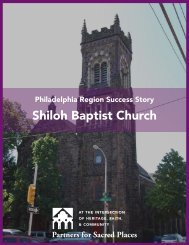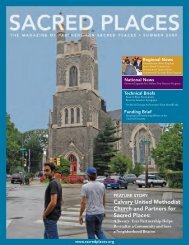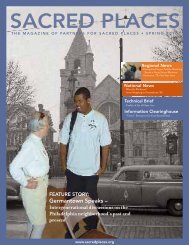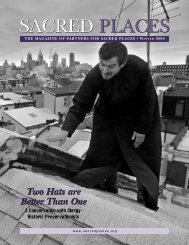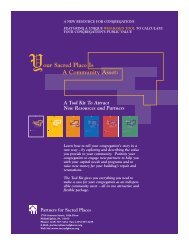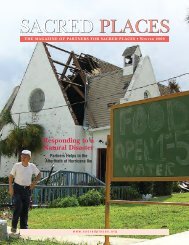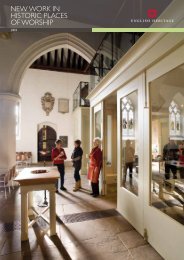FEATURE STORY - Partners for Sacred Places
FEATURE STORY - Partners for Sacred Places
FEATURE STORY - Partners for Sacred Places
You also want an ePaper? Increase the reach of your titles
YUMPU automatically turns print PDFs into web optimized ePapers that Google loves.
GG: When did you realize that you were interested in<br />
architecture and art?<br />
RD: As a young lad, I was a newspaper boy, and so I had<br />
a route from [the west side of] Racine to the east side<br />
of Loomis. And in delivering newspapers, you began to<br />
see differences in the types of residences. We lived in a<br />
bungalow. A bungalow is a very functional building. And so<br />
by delivering papers and going past all these homes, you’d<br />
see that other ones were more interesting, some could be<br />
more like an English Tudor style, some could be, maybe<br />
not Victorian, but more set back, front porches, and others<br />
might have more a French type of look. I think it was the<br />
shape and the <strong>for</strong>m and the extra artistic work, rather than<br />
the function work that made me, I responded to that.<br />
GG: I know you are a proud Chicagoan.<br />
RD: I love Chicago…I grew up in Chicago. Chicago is where I<br />
was born and raised. I could have been anywhere but Chicago<br />
turns out to be the best city <strong>for</strong> me. It's a city you can make<br />
some impact in if you want to give back.<br />
GG: In Chicago, what are some of your favorite buildings?<br />
When you drive by you say 'I love this.'<br />
RD: When I was on the south side, my favorite buildings<br />
in the immediate neighborhood would be the school and<br />
the church. There weren't any really big civic buildings.<br />
When I moved downtown in the early 1970s, I began to have<br />
greater exposure to both civic buildings and commercial<br />
buildings, as well as residences. I've made a little bit of a<br />
list. So in the Financial District, it would be the Board of<br />
Trade, the Rookery, and the Monadnock Building. And then<br />
in the Cultural District, I like the Civic Opera House, the Art<br />
Institute of Chicago, and the Field Museum.<br />
GG: Let’s talk about the architectural style, artists, and<br />
architects that you prefer.<br />
RD: Art Nouveau interests me, a style expressed in the<br />
1880s-1890s strongly in Europe. In the 1970s and early<br />
1980s, I collected decorative art from that period. Actually,<br />
I was collecting mostly poster art at that time. A French Art<br />
Nouveau architect named Hector Guimard worked a lot in<br />
iron and metal work. He designed fabulous facades. It was<br />
sort of like poetry in metal, frozen music, if you will. Art<br />
Nouveau was the style that actually came out of a rejection or<br />
change from the Industrial Revolution wherein everything<br />
was more specific, engineered or scientifically orientated.<br />
Architects and artists went back to a natural style, one that<br />
was more organic, undulating, and flowing. I have collected<br />
many pieces from this style including illustrations, metal<br />
work, vases, fireplaces, and chandeliers.<br />
Another style that I like is Art Deco. Rockefeller Center is<br />
terrific. Early gothic style interests me as well.<br />
GG: So let’s move to the international part. The caliber of<br />
architecture you like, Paris, Rome…<br />
RD: I like Paris because it is a beautiful planned city. It<br />
has orchestrated beauty, axes, and focal points. The city<br />
has consistent order and balance. Rome has more ancient<br />
architecture, which is beautiful! There was better planning<br />
then because everyone knew where to gather. Take the<br />
Coliseum.<br />
GG: Right. But even how the urban cities developed, the<br />
grid level, the avenues, and like that, it’s a Roman thing.<br />
Because that’s what the Romans would use when they would<br />
go out and conquer a city. They would raze the city and build<br />
accordingly to that plan.<br />
If we don’t save [our churches], we<br />
lose our sense of how we got here<br />
and what we did. Our history with our<br />
grandparents, our parents…we’re losing<br />
a connection to the past that will never<br />
be replaced.<br />
RD: The Romans made a lot of money – they were terrific<br />
business people. Well, originally they were warriors. Venice<br />
didn’t become a great city thru local commerce; it wasn’t so<br />
much trading with farmers but rather international trading.<br />
The Venetians traded with different places that could<br />
produce things they could not produce. There was terrific<br />
arbitrage between purchasing spices. Venice could not have<br />
been built without arbitrage and with letters of credit and<br />
banking.<br />
GG: Well, yes, they were merchants.<br />
RD: Venice was the wealthiest city in probably all of Europe<br />
at that time, in the 14th, 15th century.<br />
I would have to say Prague is a beautiful mix of styles, from<br />
early Gothic, mid-Gothic, late Gothic, Renaissance, Rococo,<br />
Art Nouveau, some International, and then Ottoman and<br />
Turkish. They were the eastern-most western city.<br />
GG: Right.<br />
RD: Prague was at one time the capital of the Holy Roman<br />
Empire. It is an extraordinary collection of styles. I also<br />
like London <strong>for</strong> its more eclectic style, planning, and<br />
architecture. Italians have probably done a better job using<br />
topography. You better positioned your buildings and city<br />
centers… and probably had more opportunities.<br />
GG: How did you develop your interest in stained glass and<br />
decorative arts? In some ways you already answered this,<br />
<strong>Sacred</strong> <strong>Places</strong> • Fall 2010 • 14




